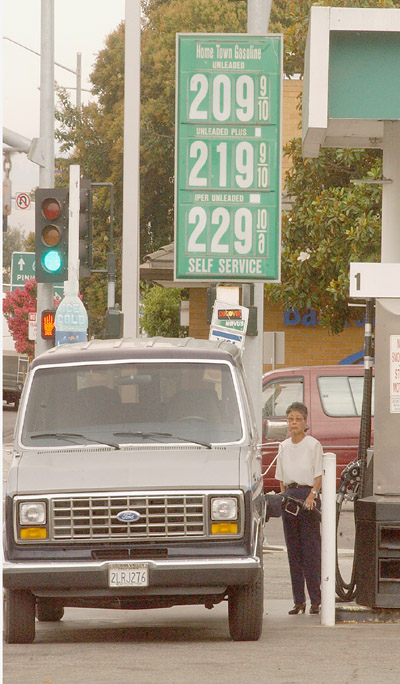
The dollar amounts on the signs in front of gas stations across
the state are increasing so fast they resemble a progressive slot
machine in Las Vegas. For local motorists the only payoff they
promise is a lighter wallet and a thirsty gas tank.
”
Gas prices are ridiculous,
”
said Walt Wright, lifelong San Benito County resident.
”
Do they think we have a lot of money laying around to pay these
prices?
”
The dollar amounts on the signs in front of gas stations across the state are increasing so fast they resemble a progressive slot machine in Las Vegas. For local motorists the only payoff they promise is a lighter wallet and a thirsty gas tank.
“Gas prices are ridiculous,” said Walt Wright, lifelong San Benito County resident. “Do they think we have a lot of money laying around to pay these prices?”
Wright, who has a ranch in the Bay Area and travels frequently to show horses, estimated his average gasoline costs are $600 a month. While the average driver doesn’t spend that much on gas, higher prices put a hold on long trips for many money-conscious consumers, like Hollister resident Angelica Lopez.
“You can’t really go anywhere long-distance, because you have to spend $40 to $50 just to get somewhere,” she said.
Lopez, who spends between $60 and $70 a month on gas commuting to school in Gilroy, said the higher prices stem from the high government taxes in California, she said.
“People’s wages get smaller and it’s harder to put gas in your tank,” she said. “I think the Federal Reserve should step in and control the gas taxes.”
The increase in gas prices has occurred because of several events that have interrupted gas production throughout the state, as well as the country, said Cynthia Harris, a spokesperson for AAA of Northern California.
“There are several reasons gas prices have gone up, one being the pipeline in Arizona,” Harris said.
The pipeline, which ruptured July 30 and has caused massive gas shortages in the Phoenix area, is forcing an increase in California’s prices because Arizona receives 70 percent of its gas from California. After the pipeline burst, that percentage increased to 85 percent, Harris said.
Another factor affecting California’s gas prices was the blackout on the East Coast last week.
“It shut down a multitude of gas refineries and fuel distributors in the Northeast and Midwest and the effects trickled down to California,” Harris said.
Also, the interruption in production at three refineries in California has also been paramount in raising prices for consumers, Harris said.
“If there is a temporary malfunction at even one refinery in California, it has a definite supply effect,” she said.
Basically, what it all boils down to is supply and demand, said Graham Mackie, a partner at Dassel’s Petroleum, Inc., a local petroleum and gas company.
“When there is a shortage in supply, which there is now, gas prices go up,” he said.
Prices have been escalating for the past two weeks and will continue, where the price for a gallon of unleaded gas may reach as high as $2.30 before they decrease, he said.
“The refining production has to return to normal and the Phoenix problem has to go away for prices to go down,” Mackie said.
With all the turbulence surrounding the mandated change from methyl tertiary-butyl ether (MTBE) to ethanol that all gas stations must comply with by the end of the year, “we won’t see prices below $2 for a while,” Mackie said.
No matter what the reason, consumers were furious with the increase in price. Nash Road Texaco employee Michael Baltierra hears their clamor on a daily basis.
“People come in and complain to me constantly,” she said. “Everyone needs gas so people pay it, but they have to give me their opinion first.”
For Hollister resident Kent Bartkowski, the prices were absolutely atrocious, he said.
“The oil companies have to make their money. They know people travel a lot in the summer, so (prices) keep escalating until Labor Day. It’s tradition.”
With the holiday weekend right around the corner, many motorists will either be staying off the roads or traveling closer to home.
“It’s too expensive to go on a trip this year,” Bartkowski said. “You’re better off staying at home.”
Many people who usually travel outside of the state will most likely stay within California this year for Labor Day, Harris said.
“(Prices) do affect traveling,” she said, “but many people have just become accustomed to higher gas prices.”
Right now, there’s nothing motorists can do to overcome the spike in prices, except shell out the money and try to drive as economically as possible, Mackie said.
“People may have to park the SUV for awhile,” he said. “There aren’t any other ways of overcoming the problem.”









